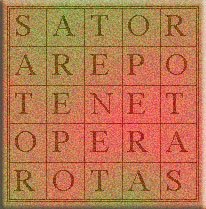
This
Palindrome picture is copied from Wikimedia where it appears in black and white; I, using Photoshop, added the colors.
The Star of David is a visual palindrome: from every direction it looks the same:
From above as from below
From the front as from the behind
From the right as from the left
This shape expresses the concept that the opposites, any pair of contrasts, are united on a level, which includes them; like breath includes inhaling and exhaling.
The Star of David is the place where it doesn't matter if you are rightist or leftist, rich or poor, at the top of the social ladder or at its bottom.
It is interesting to note that this visual palindrome attracts another visual palindrome - the Roman magic square called sator, where each word can be read the same way from right to left and vice versa, from top to bottom and vice versa. M. Costa in his book about the golden section and Solomon's seal bring a photograph of a whole page of a book from the Middle Ages in which a Star of David surrounds this magic square.
The Star of David attracts also Hebrew verbal palindromes:
The word David (DVD), which appears in the name of this shape
The word Six (Shesh in Hebrew) indicating the number of triangles that surrounds the hexagon, which dwells inside this shape. Shesh is the stem of the word Shoshan (lily), the flower that looks from above like a Star of David. Researcher Uri Ofir claims that the Shoshan is the origin of this shape.
The word Choach (thorn) from the verse in the Song of Songs
"Like a rose among the thorns"
